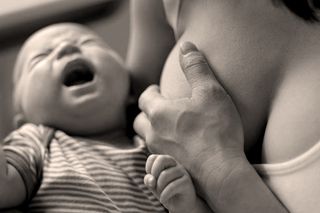
Common Breastfeeding Problems for Women (And How to Troubleshoot Them)
Pain during breastfeeding is not normal.

Not every mother can comfortably initiate and carry out the process of breastfeeding. Myths like ‘It’s normal for breastfeeding to hurt’ often lead breastfeeding women down the wrong (and more difficult) path from the beginning of their breastfeeding experience. This can lead to all kinds of breastfeeding problems.
While some discomfort is normal, experiencing prolonged breastfeeding problems, day in and day out, is not. The good news is, if you are experiencing these complications — like sore nipples; red, swollen or painful breasts — there are things you can do to ease the problem and carry on nursing your child.
Common breastfeeding problems (and how to resolve them)
Sore nipples
Breastfeeding is not supposed to hurt. However, if you do happen to develop sore, cracked or bleeding nipples, it could be due to several reasons. The most common reason for sore nipples is because the baby latches onto the breast incorrectly. This incorrect latch can contribute to bacterial or fungal (thrush) infections on the nipple, which can also cause sore, cracked or bleeding nipples. Finally, tongue tie, a physiological condition that restricts the baby’s movement of their tongue, can also affect proper latching and feeding, and contribute to nipple discomfort for the mother.
What to do for sore nipples during breastfeeding:
You can look at using warm, damp compresses to ease the soreness. Immediately before breastfeeding, try administering the warm compress to the least-sore side, then hand-express to stimulate the let-down effect.
In case of severe soreness, you can look at using rubber or silicone nipple shields to assist a baby’s latch and prevent aggravation of the sore nipple. Finally, do reach out for professional lactation support if the pain doesn’t subside within 24 hours.
How to prevent sore nipples during breastfeeding:
Never use alcohol-based cleansing pads or colognes, or herbal breast creams, to clean nipples. These will dry out the nipple, causing the skin to crack and become sore. Instead, simply use water to clean your nipples.
Read more: 15 Things Everyone Tells You About Breastfeeding That Aren’t True
Engorgement
Engorgement occurs when when the breast becomes over-full with milk. Engorged breasts feel very full, and become hard, swollen, hot and/or painful. Engorgement is often mistaken for breast fullness — but all new mothers who are breastfeeding at regular intervals should know that their breasts shouldn’t be full beyond the 24 to 48 hours after delivery. Engorgement is not normal and it shouldn’t be treated as such.
Engorgement is typically due to latching problems that cause an inadequate transfer of breast milk to the baby, but a missed feed or a nursing strike may also lead to engorgement.
What to do for breast engorgement during breastfeeding:
In order to reduce engorgement, continue feeding 8 to 12 times in 24 hours. At the end of each feed, use a breast pump to ensure you fully drain the breast(s), which will reduce engorgement without stimulating more milk production.
You might also want to try soaking your breasts in a warm tub or wrapping them in warm compresses. Alternatively, you may also want to use cool packs between feeds. Warmth causes vessels to dilate, which prompts the leakage/drainage of breast milk. But, since engorgement also involves tissue swelling, icing your breasts can ease the pain and heat. It will vary from individual to individual which treatment (or both) works best to relieve engorgement from breastfeeding.
Additionally, a lymphatic drainage massages may help, too. When any tissue, including breast tissue, becomes inflamed (as in engorgement), the body increases its production of lymph fluid, which carries away waste products from the affected site. A massage focused on the breasts, armpits and arms, where lymph nodes are located, can help drain this excess fluid and ease engorgement.
How to prevent breast engorgement:
The best way to avoid engorgement is to breastfeed (or pump) at regular intervals and ensure that the baby is latching and positioned correctly while doing so.
Blocked ducts
Mothers with abundant milk supply often face this as a common breastfeeding problem because their breasts are not drained completely while feeding, leaving milk to build up in their milk ducts. That build-up can plug the duct, preventing milk from reaching the baby. Flow reduces, and for this reason, many women mistake blocked ducts for decreasing production of milk.
Blocked ducts may be sore, swollen and even painful. There are various contributing factors for blocked ducts, including tight and constricting bras, poor diet, stress, a skipped feed, or an improper latch.
What to do for blocked milk ducts:
If you have blocked ducts, continue to feed as usual, but be sure to position the baby in a way that allows for maximum pressure around the blocked area, upon their latching. (This position will vary for individuals.)
You may also want to use anti-inflammatory medication, to ease swelling, and a warm, damp compress between feeds, as heat helps vessels dilate and will aid in unplugging the duct.
How to prevent blocked ducts during breastfeeding:
Placing the baby in various breastfeeding positions, across different feeds, will alternate pressure on the breasts’ ducts and help them remain clear. Most importantly, avoid tight clothing that constricts your breasts (and the ducts inside them).
Read more: 16 More Things Everyone Tells You About Breastfeeding That Just Aren’t True
Mastitis
Lactation mastitis occurs when breast tissue becomes inflamed, often from an underlying infection. Often confused with the flu, mastitis symptoms could include redness, hardness, soreness, pain, swelling or heat in the breasts, generally feeling run down, and/or a high fever with chills. It usually occurs 10 to 28 days postpartum, as the body is still adjusting to lactating and breastfeeding, and immunity is low. But mastitis can occur at any point during breastfeeding.
What to do for lactation mastitis:
Mastitis needs the immediate attention of a doctor who can prescribe the antibiotics required to treat the infection. If left untreated, mastitis can develop into a breast abscess, where the infection starts eating into the breast tissue, and could require hospitalization.
How to prevent lactation mastitis:
Stress, lack of sleep, a high-sodium diet (which constricts vessels, causing drainage problems) and restrictive clothing, can contribute to mastitis. To avoid mastitis, sleep well, eat healthily, dress comfortably, ensure that your breasts and nipples are dry, feed often and in different positions, and express milk in case of a missed feed.
Vanshika Gupta Adukia is a Mumbai-based physiotherapist who specializes in antenatal, postnatal and pelvic floor care, a childbirth educator, and the founder of Therhappy. She holds a Bachelor of Physical Therapy degree from DY Patil University, Mumbai, and is a CAPPA Certified Lactation Educator. An avid reader, she is passionate about women's health, little babies, all things colorful and happiness.
Related


Discussing Hypnobirthing Techniques With Your Obstetrician
